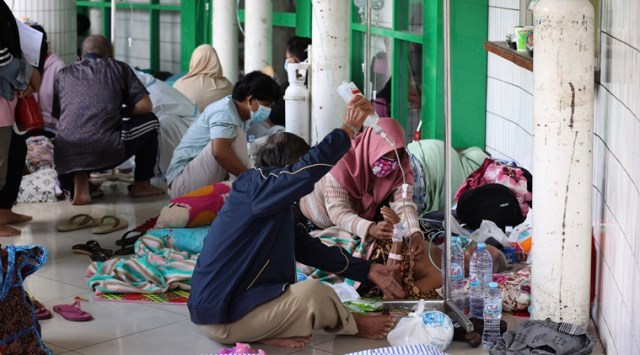- India
- International
Why Covid should spur moves towards universal healthcare in India
The health crisis has affected the economy, taken a toll on livelihoods. Increasing accessibility and affordability of healthcare should be part of the healing process
 Oxygen cylinders being readied for patients in the hallway of an overcrowded hospital amid a surge in Covid cases (AP photo)
Oxygen cylinders being readied for patients in the hallway of an overcrowded hospital amid a surge in Covid cases (AP photo)As India’s second Covid-19 wave recedes, it leaves behind an indelible mark on the country’s living memory. More than 4 lakh lives have been lost during the pandemic. It is estimated that maximum deaths occurred below the age group of 50. Many of those who died were the sole breadwinners of their families, leaving behind children exposed to an uncertain future. The human tragedy behind the statistics of the second wave will continue to disturb our conscience for a long time.
The pandemic has created a dual crisis, pertaining to health and economy. At least 230 million Indians are said to have fallen below the poverty line during the first lockdown in 2020. It exacerbated the longstanding problem of unavailability, inaccessibility and unaffordability of health services, particularly in urban areas. With patients having to bear healthcare expenses, household savings were depleted at a time when livelihoods have been drastically affected. Increased hospitalisations put an immense burden on the existing healthcare system.
As India begins to heal, we must all ask ourselves a question: How can the country equip itself so that it never faces such a dire situation ever again? The answer lies in increased investment in health systems to achieve universal health coverage (UHC) with a sharper focus on primary healthcare. This suggestion is old wine in a new bottle. It was first recommended in pre-independent India by the Sir Joseph Bhore Committee, followed by several committees set up by the Government of India, WHO’s “Health for All” Alma-Ata Declaration four decades ago, and more recently at Astana in 2018. It is an old idea whose time may have finally come. Primary healthcare remains the most inclusive, effective, and efficient approach to address public health needs – the emphasis should be on preventive care to minimise burden on the existing infrastructure.
UHC promises every individual access to quality healthcare, including promotive, preventive, curative, rehabilitative and palliative health services, without financial hardship. The global Covid-19 experience has proved the need to revisit the requisites germane to Target 3.8 of the SDGs — UHC, in the most practical and workable sense.
 Moving towards UHC requires strengthening health systems well described in WHO’s 2007 framework through six “building blocks”: Service delivery, health workforce, health information systems, accessible essential medicines, health financing and governance. Responsiveness and efficacy of the building blocks of health systems can be significantly enhanced by answering three policy questions around UHC: Who is covered? Which services are covered? What amount of the costs are covered?
Moving towards UHC requires strengthening health systems well described in WHO’s 2007 framework through six “building blocks”: Service delivery, health workforce, health information systems, accessible essential medicines, health financing and governance. Responsiveness and efficacy of the building blocks of health systems can be significantly enhanced by answering three policy questions around UHC: Who is covered? Which services are covered? What amount of the costs are covered?

India can learn from other countries and turn its experience in battling the pandemic into a set of unique opportunities. Countries such as Vietnam, Sri Lanka, South Korea, and Thailand in the Asia Pacific have shown just how early investment in UHC-focused resilient health systems made them well-prepared to battle the pandemic.
Before Covid-19 hit, India had been making small but significant strides towards UHC. However, the pandemic has adversely impacted these efforts with rising challenges such as insufficient funds, high out-of-pocket expenses, poor access to healthcare, gender inequities, reduction in quality and efficiency of medical services.
The National Health Policy 2017 laid out the roadmap to achieving UHC. It recommends the government increase the health budget from the existing 1.15 per cent to 2.5 per cent of the GDP by 2025 and decrease the proportion of households facing catastrophic health expenditure from the current levels by 25 per cent, till 2025. More recently, the 15th Finance Commission made similar recommendations related to an increase in state expenditure for health systems strengthening by 2022. However, it is yet to see the light of the day. To make a meaningful impact, it is important for all states to increase their state health expenditure by over 8 per cent of their budget.
The Government of India has taken a few strong measures by creating a window of opportunity for speeding up UHC implementation. Health allocation saw a 138 per cent increase in the Union Budget, 2021-22, with approximately Rs 64,180 crore allocated to the Atmanirbhar Swasth Bharat Yojana over the next six years to ramp up primary, secondary and tertiary healthcare systems. Ayushman Bharat, to an extent, is moving towards addressing sustainable and comprehensive primary healthcare by operationalising more than 75,500 wellness centres. It has provided for covering Covid-19 testing and treatment expenses for eligible beneficiaries. In a welcome move, Covid-19 vaccinations have been made free for all in government hospitals and health centres. If Ayushman Bharat can gradually cover the ambulatory care expenses as well, it will be a major step towards accelerating the pace of universal health coverage in India.
While public funding is key to driving UHC in India, the inclusion of the private sector remains an unfinished agenda. Private sector is indispensable to UHC since it caters to around 70 per cent of Indians’ healthcare needs. The government must take the lead in addressing the trust deficit and regulate the private sector to collectively deliver on the realisation of UHC. Countries in the Asia Pacific have begun to take steps towards catalysing private sector engagement in the effort to promote equity, access, quality and financial protection for their population. It would be prudent for the Centre to create a division on private sector partnership in the Ministry of Health and Family Welfare.
When both last-mile population as well as the targeted range of benefits are prioritised, results are more tangible. Strengthening social safety nets for the vulnerable, and economically deprived must be facilitated as a part of the national development agenda in the next 4-5 years, including establishing service delivery systems for migrants.
India entered a 37-year period of demographic dividend in 2018. Such periods are marked by rapid double-digit economic growth. Japan, China, South Korea, and Singapore were able to tap the potential of their young working population during their time and showcase tremendous progress. India, too, will need to harness the economic potential of the youth and turn it into a success story. The government, especially the Health, Education, Skills Development and Youth Affairs Ministries, will have to develop a roadmap focusing on the youth and ensure they have access to good health, quality education and decent employment to make it happen.
Lastly, the three questions around coverage, services and funds require a strong political will. Health must be turned into an issue of the masses, particularly urban health which warrants attention in the wake of Covid-19 pandemic. It is for these reasons that increased investments in UHC (with an urban primary healthcare focus) will enable us to build back better.
The author is a former Joint Secretary of the Ministry of Health and Family Welfare, Government of India
EXPRESS OPINION
Apr 25: Latest News
- 01
- 02
- 03
- 04
- 05










































